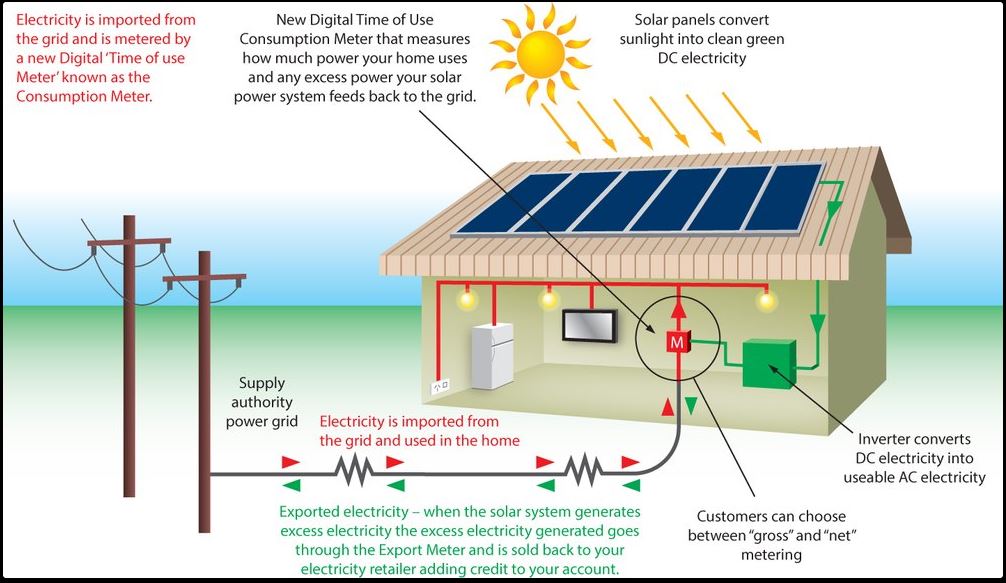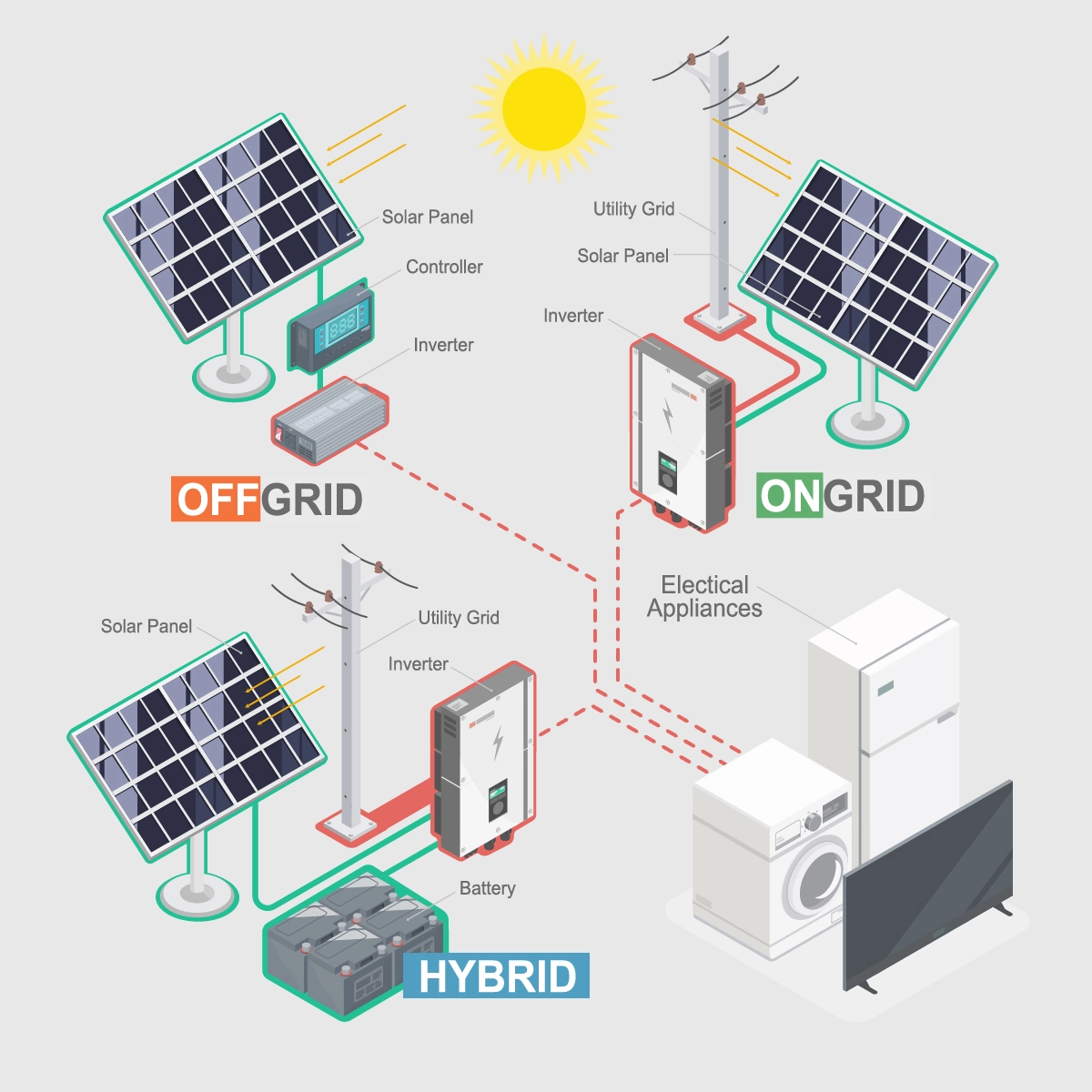Add Heading Here

8500626600
Residential Solar Setup
A residential solar system lets homeowners generate clean, renewable energy from their rooftops, reducing electricity bills and dependence on the grid. Available in on-grid, off-grid, and hybrid setups, with optional battery backup for uninterrupted power. With minimal maintenance and government incentives, solar is a smart, sustainable investment that adds value to your home.
Assess Your Energy Needs
Site Survey & Feasibility
Obtain Approvals & Documentation
Panel Installation
Inspection & Commissioning
Monitoring & Maintenance
5 KWP Solar System :
Generation: 750 Units/Month
UNITS = KWP * 5 * Day’s
1 month Units = 5*5*30 = 750
Rs/Month = 750*9.5 = 7125
Components of Residential Solar Systems
- SOLAR PANELS: These are the most visible part of a solar system. They convert sunlight into electricity using photovoltaic (PV) cells. The efficiency of solar panels can vary; common types include monocrystalline, polycrystalline, and thin-film panels. Monocrystalline panels generally offer the highest efficiency and space-saving advantages.
- Inverter: The inverter is crucial as it converts the direct current (DC) generated by the solar panels into alternating current (AC), which is used by most household appliances. There are different types of inverters: String Inverters: Used for systems with multiple panels connected in series. Microinverters: Installed on each panel individually, allowing for better performance in shaded conditions. Power Optimizers: Work similarly to microinverters but are used with string inverters to enhance efficiency.
- Mounting System: This includes racks or brackets that hold the solar panels in place on rooftops or ground mounts. Proper mounting ensures optimal angle and stability.
- Battery Storage (Optional): Some homeowners choose to include battery storage systems to store excess energy generated during the day for use at night or during power outages. Popular options include lithium-ion batteries like the Tesla Powerwall.
- Monitoring System: Many modern systems come with monitoring technology that allows homeowners to track energy production and consumption through apps or online platforms.

Types of Residential Solar Systems
- Grid-Tied Systems: These systems are connected to the local utility grid. They allow homeowners to sell excess power back to the grid through net metering agreements while drawing from the grid when needed.
- Off-Grid Systems: Designed for homes not connected to the utility grid, these systems rely on battery storage to provide electricity independently. They require larger battery banks and careful planning regarding energy consumption. String Inverters: Used for systems with multiple panels connected in series. Microinverters: Installed on each panel individually, allowing for better performance in shaded conditions. Power Optimizers: Work similarly to microinverters but are used with string inverters to enhance efficiency.
- Hybrid Systems: Combining elements of both grid-tied and off-grid systems, hybrid setups can operate independently during outages while still being connected to the grid under normal conditions.

Benefits of Residential Solar Systems
- Cost Savings: Homeowners can significantly reduce their electricity bills by generating their own power. Depending on local incentives and net metering policies, many can recoup their investment within a few years.
- Environmental Impact: Solar energy is clean and renewable, reducing reliance on fossil fuels and lowering greenhouse gas emissions.String Inverters: Used for systems with multiple panels connected in series. Microinverters: Installed on each panel individually, allowing for better performance in shaded conditions. Power Optimizers: Work similarly to microinverters but are used with string inverters to enhance efficiency.
- Energy Independence: Generating your own electricity provides greater control over energy costs and reduces vulnerability to rising utility rates.
- Increased Property Value: Homes equipped with solar systems often see an increase in property value due to lower operating costs and appeal as eco-friendly properties.
Installation Process
- Site Assessment: A professional installer evaluates your home’s roof orientation, shading issues, structural integrity, and local regulations.
- EnvironSystem Design: Based on the assessment, a customized design is created that outlines panel placement, inverter selection, and any necessary permits.mental Impact: Solar energy is clean and renewable, reducing reliance on fossil fuels and lowering greenhouse gas emissions.String Inverters: Used for systems with multiple panels connected in series. Microinverters: Installed on each panel individually, allowing for better performance in shaded conditions. Power Optimizers: Work similarly to microinverters but are used with string inverters to enhance efficiency.
- Permitting: The installer will handle obtaining necessary permits from local authorities before installation begins.
- Installation Day(s): Installation usually takes one to three days depending on system size; this includes mounting panels, wiring connections, installing inverters/batteries if applicable.
- Inspection & Interconnection: After installation is complete, inspections are conducted by local authorities or utility companies before connecting the system to the grid.
- Activation & Monitoring Setup: Once approved, your system will be activated; you’ll also set up monitoring tools if included.
DOMESTIC POWER BILL
LT-I(A): Upto 100 Units/Month
UNITS : Rs
0-50 : 1.95
51-100 : 3.1
LT-I(B)(i): Above 100 Units/ Month to 200 Units
UNITS : Rs
0-100 : 3.4
101-200 : 4.8
LT-I(B)(ii): Above 100 Units/Month
UNITS : Rs
0-200 : 5.1
201-300 : 7.7
301-400 : 9
401-800 : 9.5
800-Above : 10


